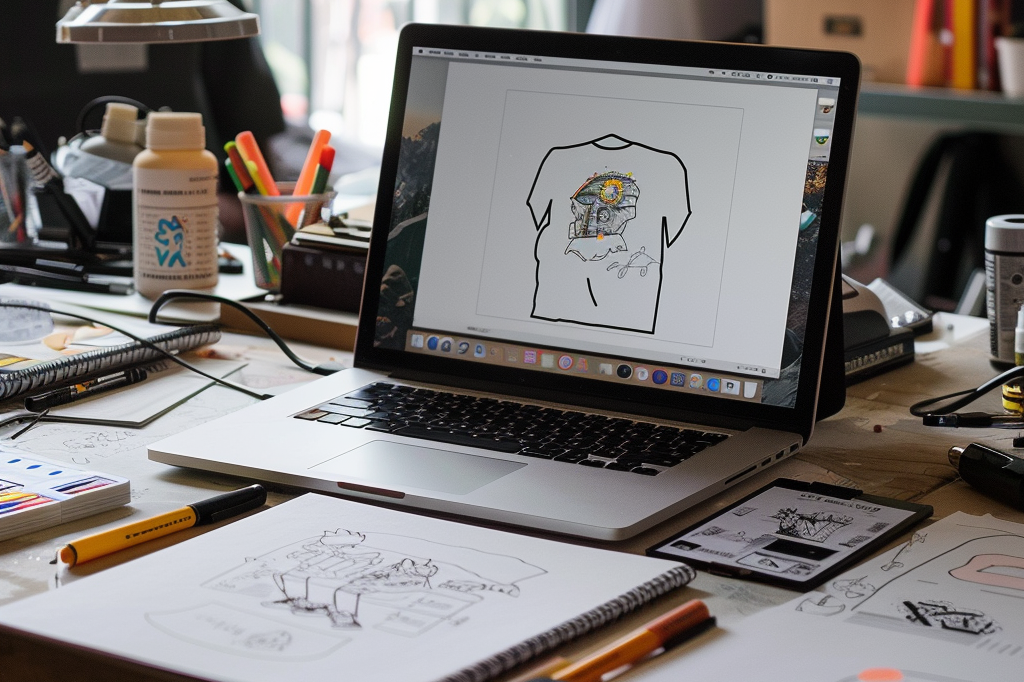Creating unique t-shirt designs can be exciting, but it’s easy to feel overwhelmed by the process. You might wonder how to start, protect your ideas, and make sales.
To create, protect, and sell your t-shirt designs, use professional design software or platforms like Canva, understand patenting basics, and leverage online marketplaces for sales.
Let’s explore how to design, protect intellectual property, and make your ideas profitable.
What program should you use to make shirt designs?
Designing t-shirts starts with choosing the right tools. Not all design programs are created equal, and selecting one depends on your needs.
Adobe Illustrator, Photoshop, and Affinity Designer1 are top choices for professional t-shirt designs, offering detailed customization and high-quality outputs.
Online platforms like Canva are simpler alternatives. Let’s explore both approaches.

Key Features of Professional Design Tools
Professional tools like Adobe Illustrator offer precision and scalability, making them perfect for intricate designs or bulk printing needs.
- Vector capabilities: Maintain quality at any size.
- Layer control: Simplify complex designs.
- Export formats: Ready for professional printing.
However, these tools have steep learning curves. Beginners might find free or low-cost alternatives like Inkscape more accessible.
Online Platforms: Easier for Beginners
Platforms like Canva provide pre-made templates and drag-and-drop interfaces. While they don’t match the flexibility of professional tools, they’re perfect for simple designs or testing concepts quickly.
| Tool/Platform | Best For | Price Range |
|---|---|---|
| Adobe Illustrator | Professional, scalable designs | $20+/month |
| Photoshop | Image-heavy designs | $20+/month |
| Canva | Beginners, quick designs | Free to $12.99 |
| Inkscape | Free vector design tool | Free |
Understanding your project needs helps you choose the right platform without overspending on unnecessary features.

Can you use Canva to design t-shirts to sell?
If Canva’s user-friendly design appeals to you, you may wonder if it’s sufficient for commercial purposes.
Yes, you can use Canva to design t-shirts for selling2, but you must comply with their licensing terms, especially for commercial use.
Let’s clarify what you need to know.
Canva’s Licensing Terms for Selling Designs
Canva offers two types of licenses:
- Free License: You can use free elements for commercial purposes, but attribution may be required.
- Pro License: Includes access to more assets with extended rights, perfect for selling designs.
Tips for Using Canva for T-Shirts
- Use original elements or customize heavily.
- Export designs in high resolution for printing.
- Avoid using Canva templates “as-is” to ensure originality.
Limitations to Consider
While Canva is great for beginners, it doesn’t offer advanced tools like vectors, which can impact printing quality. For professional projects, combining Canva with tools like Illustrator may work better.
How do you patent your t-shirt design?
Protecting your unique t-shirt ideas ensures you maintain ownership and avoid copycats. But do you need a patent?
Patenting a t-shirt design involves filing with the intellectual property office3 in your country, often for the specific artwork or design elements.
Let’s break it down.
Steps to Patent Your Design
- Check eligibility: Ensure your design is original and unique.
- Prepare documentation: Include sketches, descriptions, and proof of originality.
- File with your local IP office: In the U.S., this is the USPTO; in Europe, the EUIPO.
- Pay the filing fees: Costs vary by region.
Alternatives to Patents
If the patent process feels overwhelming, consider simpler protections like trademarks or copyrights. These options can safeguard your design without the complexity of a patent.
| Protection Type | What It Covers | Cost | Duration |
|---|---|---|---|
| Copyright | Original artwork | Low (or free) | Lifetime + 70 yrs |
| Trademark | Logos, branding | Medium | Renewable |
| Patent | Innovative designs | High | 15-20 years |
Understanding these options helps you choose the most practical method for protecting your work.

Can you sell a design without a patent?
You might wonder if skipping the patent process altogether is an option.
Yes, you can sell t-shirt designs without a patent4 by relying on copyright protections and marketplace terms.
But there are important caveats.
Copyright vs. Patent
While patents protect unique inventions, copyright automatically safeguards original artistic works upon creation. For most t-shirt designs, copyright provides sufficient protection without the hassle of patent filing.
Selling on Marketplaces
Platforms like Etsy, Redbubble, or Shopify5 allow you to sell designs directly.
- Ensure originality: Use unique designs to avoid legal disputes.
- Know platform rules: Follow copyright and usage policies.
- Watermark previews: Prevent unauthorized use of your work.
| Marketplace | Best For | Seller Fees | Audience Reach |
|---|---|---|---|
| Etsy | Handmade/artistic designs | Listing + % sales | Large |
| Redbubble | Print-on-demand sales | % sales | Medium |
| Shopify | Independent storefronts | Monthly fee | Customizable |
Combining copyright protection with strategic selling practices can make your t-shirt business successful without the need for patents.
Conclusion
Creating, protecting, and selling t-shirt designs doesn’t have to be overwhelming. By choosing the right tools, understanding licensing, and exploring protection options, you can confidently bring your ideas to life. Take the first step today, and let your creativity drive your success.
-
Explains why Adobe Illustrator and other professional tools are excellent for t-shirt design. ↩
-
Details Canva’s licensing policies for selling designs commercially. ↩
-
Outlines the patenting process to protect t-shirt designs. ↩
-
Discusses copyright and trademark alternatives for protecting designs. ↩
-
Guides readers on selling platforms like Etsy, Redbubble, and Shopify. ↩













